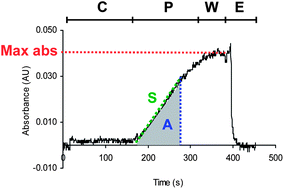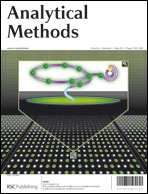Automated solid-phase spectrophotometric system for optosensing of bromate in drinking waters†
Abstract
An automated method based on an optosensor included in a multisyringe flow injection system was developed for the determination of bromate in waters for human consumption. The optosensor was based on the formation of a colored radical cation after oxidation of chlorpromazine by bromate and its selective uptake in a mixed-mode cation exchanger sorbent (Discovery DSC-MCAX), placed on a flow-through spectrophotometric cell. In-line regeneration was attained by methanol + 5% (v/v) ammonia, fostering the application of the same sorbent portion up to 180 determinations. Parameters affecting the reaction development and uptake of the colored compound were studied and optimized, while in-line addition of sulfite (≥0.100 g L−1) prevented interference from hypochlorite. The proposed methodology allowed the determination of bromate up to 50.0 μg L−1, with 0.9 μg L−1 as the limit of detection, meeting the requirements of current EU and USA legislation. Application to real drinking water samples was successful, with a mean recovery of 100.2 ± 2.8% for spiked levels of 5.0, 10.0 and 25.0 μg L−1. Repeatability was good (RSD < 3.6%, n = 10) with a determination throughput of 8 h−1, fostering the application to on-line control of water disinfection processes.


 Please wait while we load your content...
Please wait while we load your content...